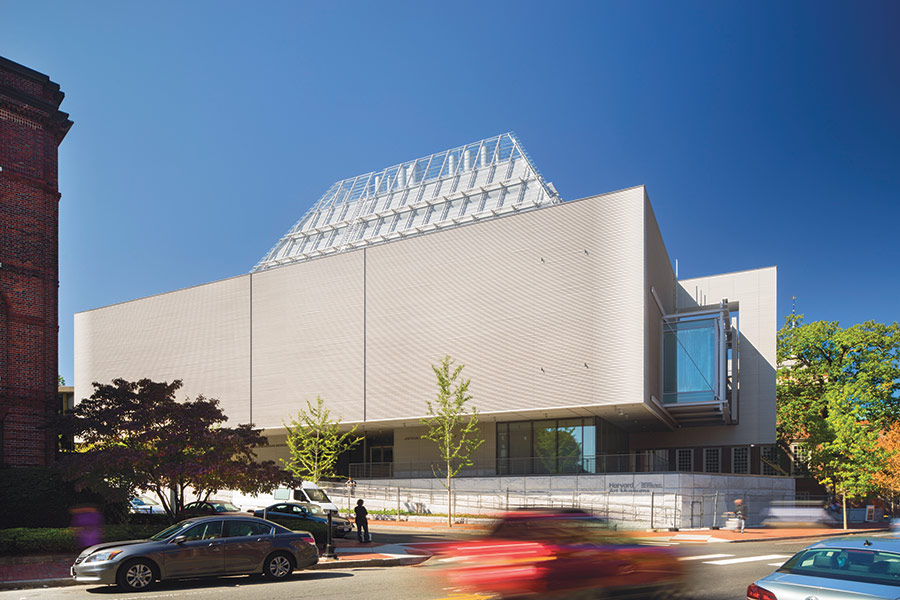
The recently opened Harvard Art Museums consolidates under one roof the university’s three art museums: the Fogg, the Busch-Reisinger, and the Arthur M. Sackler. Combined, these institutions boast larger holdings than the Boston MFA, some 250,000 objects, all of which are available to students by request. Designed by Renzo Piano Building Workshop in collaboration with Payette, the new facility’s purpose is to make this impressive collection more accessible with the hope of encouraging scholarship. At 200,000 square feet, it includes galleries, teaching spaces, and a sizeable conservation studio, as well as an auditorium and lecture hall.
The site chosen for the new facility was that of the existing Fogg, a protected 1927 Georgian revival edifice that had been added to several times over the years. The design team completely overhauled the Fogg, stripping it down to the landmarked portions of the building, which left the facade and about two thirds of the floor space, including an arcaded courtyard. A new Alaskan White Cedar and glass–clad, steel-framed structure was then added that seamlessly integrates with the historic building. A circulation corridor was cut through from Quincy Street to Prescott Street and a sloping, steel-framed glass roof links the old and the new.
|
|
||||
“Renzo’s concept was to rip out the existing roof and put in a clear glass roof so that you would be able to see the sky,” said Robert Silman, president emeritus of structural engineering firm Robert Silman Associates (RSA), which worked with the architects on the project. “It’s a trademark of his work. This project, the Morgan, and the Whitney, all of which we worked on, have this characteristic. He likes to articulate the components and to make them visible. Slick isn’t what he’s after. There ought to be visible clarification of the primary, secondary, and tertiary members, and how the glass interacts with that framework. That’s the stuff you have to work on in collaboration from the beginning, or it doesn’t happen.”
The glass roof support structure is made up of double king post trusses that interlock to form its two halves. RSA performed extensive studies and worked closely with German fabricator Josef Gartner to engineer the system’s main structural components to a high-degree of precision so that it joins seamlessly with the existing building and the new steel-framed addition. The design team was able to convince the department of buildings to consider the roof a skylight, allowing them to only fireproof the structure’s hip brackets, a job that was accomplished with an intumescent coating. The rest of the structure is exposed, putting Piano’s carefully thought out connections on view for contemplation.
|
RESOURCES: |
||
|
|
||
The conservation studio occupies the majority of the top floor, the fifth, giving the conservators access to abundant daylight. The fourth floor is dedicated to teaching, while second and third floors are reserved for gallery space. The first floor houses offices and through-building public circulation linking the Harvard campus across Quincy Street with Prescott Street. Throughout the lower floors, the engineering team was challenged with integrating modern mechanical systems with a structure whose beam dimensions and floor-to-floor heights matched the 1920s building. This required multiple pre-planned openings in beams through which to thread the services. The team also designed a frame with closely spaced beams whose bays are expressed with arched ceilings that maximize headroom.
The east side of the addition cantilevers at the second floor over a ramped walkway that links Broadway with the Prescott Street entrance. To the south, this walkway ties into Le Corbusier’s Carpenter Center ramp. Floor-height trusses concealed within the walls support the cantilever over multiple bays of framing and allow for roomy column-free gallery spaces in this section of the addition. To the north and south, glass-enclosed galleries protrude from the main volume of the addition. Mechanically operated wood sunscreens in these sections give curators the ability to control the amount of daylight admitted into the galleries. Here, RSA had to keep building movement within tight tolerances to prevent the screens from binding when slid open or closed.
The auditorium and lecture hall were allocated to the basement, which required a significant excavation of the tight sight. RSA used a slurry wall foundation system that was cross-braced during excavation. In the final construction, the subterranean levels’ floor framing braces the concrete foundation walls. This was a tricky procedure because the ramp of the Carpenter comes down on top of the auditorium roof. It had to be temporarily shored during construction. “We had to hold up the ramp while we demolished a library that was on that spot and built the addition, simply because it’s Corbu,” said Silman. “It’s a block of concrete!” Work of genius or pile of cement, Skanska, which handled the construction, did its work carefully. The Carpenter ramp suffered no damage. Not that you could tell. In the words of Silman, “It’s pretty beat up as it is.”